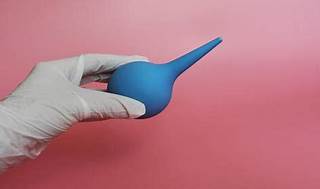An adult patient has orders for an enema. A nurse will
Give the enema to the patient while he or she sits on the toilet.
Insert the tip of the enema tube into the rectum pointing towards the umbilicus.
Have the patient lie on the right side to facilitate the instillation of water.
Chill the water to a temperature between 75°F and 85°F.
The Correct Answer is B

The correct answer is choice b. Insert the tip of the enema tube into the rectum pointing towards the umbilicus.
Choice A rationale:
Giving the enema while the patient sits on the toilet is incorrect because it can cause discomfort and does not allow for proper administration of the enema solution.
Choice B rationale:
Inserting the tip of the enema tube into the rectum pointing towards the umbilicus is correct because it follows the natural curvature of the rectum and colon, ensuring effective delivery of the solution.
Choice C rationale:
Having the patient lie on the right side is incorrect. The left lateral position is typically recommended for enema administration as it allows the solution to flow more easily into the sigmoid colon and descending colon.
Choice D rationale:
Chilling the water to a temperature between 75°F and 85°F is incorrect. The enema solution should be warmed to body temperature (around 99°F to 106°F) to avoid causing cramping or discomfort.
Nursing Test Bank
Naxlex Comprehensive Predictor Exams
Related Questions
Correct Answer is A
Explanation
Choice A Addressing the cause of the patient's anxiety and fear is the priority to provide
emotional support and comfort. The nurse should actively listen to the patient's concerns and offer appropriate reassurance and information.
Choice B While assessing the patient's bowel sounds and gas is important for the overall care, it is not the priority at this moment when the patient is expressing fear and anxiety.
Choice C Addressing the family's questions is important, but the patient's emotional wellbeing should be the immediate focus.
Choice D Respiratory assessment is essential but is not the priority when the patient is expressing fear and anxiety about the upcoming surgery.
Correct Answer is B
Explanation
Choice A: KoolAid is not an ideal choice for rehydration as it is high in sugar and may exacerbate diarrhea and dehydration.
Choice B : Gatorade is a suitable option for rehydration because it contains electrolytes (sodium, potassium, and chloride) that help replace those lost through diarrhea. It can help maintain
electrolyte balance and improve hydration.
Choice C Orange juice is not recommended during active diarrhea as it is acidic and may irritate the gastrointestinal tract, potentially worsening diarrhea.
Choice D Cola beverages are not recommended for rehydration as they contain caffeine, sugar, and carbonation, which can further contribute to dehydration.
Whether you are a student looking to ace your exams or a practicing nurse seeking to enhance your expertise , our nursing education contents will empower you with the confidence and competence to make a difference in the lives of patients and become a respected leader in the healthcare field.
Visit Naxlex, invest in your future and unlock endless possibilities with our unparalleled nursing education contents today
Report Wrong Answer on the Current Question
Do you disagree with the answer? If yes, what is your expected answer? Explain.
Kindly be descriptive with the issue you are facing.
